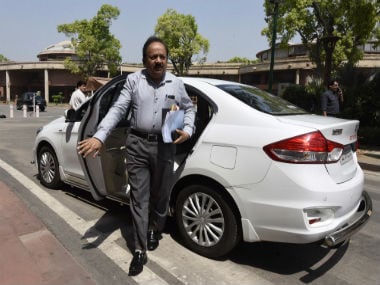Union Health Minister Dr Harsh Vardhan today inaugurated the 13th Conference of Central Council of Health and Family Welfare (CCHFW) in New Delhi, to “build consensus on national health priorities” with members of the NITI Aayog, as well as the health ministers of 13 states. Dr Harsh Vardhan urged the states to increase spending on health to 8% of their state budget, in an effort to raise the national health spending to 2.5% of gross domestic product by 2025 - as proposed in the National Health Policy 2017. [caption id=“attachment_7479871” align=“alignleft” width=“380”]
 Dr Harsh Vardhan. Image source: Getty Images.[/caption] During the first session of the conference, the minister also launched a new initiative: the Surakshit Matritva Aashwasan (SUMAN), for zero preventable maternal and newborn deaths. NITI Aayog data show that India has been making some strides in these areas already. On 9 October, the health minister had told the Union Cabinet that maternal mortality ratio (MMR), the under-five mortality rate (U5MR) and infant mortality ratio (IMR) have been on the decline in India. And that at the current rate, India should able to reach its Sustainable Development Goal (SDG) target of MMR under 70 per 100,000 live births and U5MR of 25 per 100,000 before 2030. India is a signee to the 17 SDGs, to eradicate poverty and hunger, promote well-being and good health, work towards gender equality, and ensure peace and prosperity for every human being by 2030. In his recent visit to the US from 21-27 September 2019, Prime Minister Narendra Modi had also deliberated on the attainment of SDGs in India.
Dr Harsh Vardhan. Image source: Getty Images.[/caption] During the first session of the conference, the minister also launched a new initiative: the Surakshit Matritva Aashwasan (SUMAN), for zero preventable maternal and newborn deaths. NITI Aayog data show that India has been making some strides in these areas already. On 9 October, the health minister had told the Union Cabinet that maternal mortality ratio (MMR), the under-five mortality rate (U5MR) and infant mortality ratio (IMR) have been on the decline in India. And that at the current rate, India should able to reach its Sustainable Development Goal (SDG) target of MMR under 70 per 100,000 live births and U5MR of 25 per 100,000 before 2030. India is a signee to the 17 SDGs, to eradicate poverty and hunger, promote well-being and good health, work towards gender equality, and ensure peace and prosperity for every human being by 2030. In his recent visit to the US from 21-27 September 2019, Prime Minister Narendra Modi had also deliberated on the attainment of SDGs in India.
Maternal care and childcare
According to the NITI Aayog data, India has stepped up its efforts to reduce MMR and IMR: MMR dropped 8% in India, to 130 per 100,000 live births - the aim is to reduce this to 70 per 100,000 live births by 2030. NITI Aayog data also report a decrease of 6.6% in U5MR and 4.7% in IMR in India. MMR refers to the death of a woman during pregnancy or within 42 days of termination of pregnancy. According to a study conducted in 2014, the leading causes of MMR in India are haemorrhage, high blood pressure, gestational diabetes, pre-eclampsia (high blood pressure and protein in urine during pregnancy), preterm labour, and miscarriage. According to the UNICEF, the biggest reasons for infant mortality in India are a premature birth, neonatal (newborn) infection, and birth complications or congenital malformations (which exist right from birth).
Steps towards improvement
Apprising the Prime Minister and the Cabinet on the progress under the National Health Mission (NHM) on Wednesday, the health minister also shared some data on how they were able to reduce mortality in mothers-to-be, new moms and babies under 5 years:
- POSHAN Abhiyaan for Home-Based Care for Young Child was introduced to decrease the ratio of U5MR and IMR.
- 30.5 crore children reportedly received the Measles-Rubella vaccine in 2019.
- By 2018-19, the Rotavirus vaccine was introduced in all the states of India, to prevent diarrhoea in young children.
- In 2018-19, Pneumococcal Conjugate Vaccine was extended to many other states of India to prevent pneumococcal diseases like pneumonia in infants.
- In 2018-19, 17,149 Ayushman Bharat - Health and Wellness Centres were reportedly established. Around 181,267 health workers - including Accredited Social Health Activists (ASHAs), Multi-Purpose Health Workers, Staff Nurses and Public Health Centre - were trained in the management of non-communicable diseases, according to the government data.
Health articles in Firstpost are written by myUpchar.com, India’s first and biggest resource for verified medical information. At myUpchar, researchers and journalists work with doctors to bring you information on all things health. For more information on pre-eclampsia, please read our article here _._
)